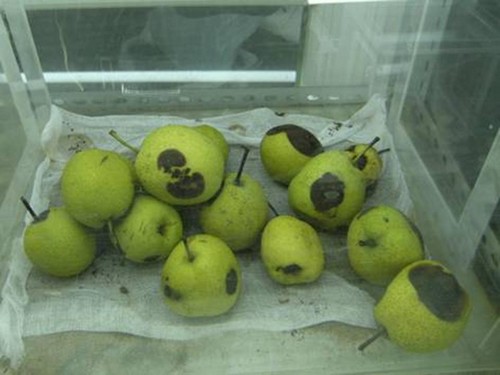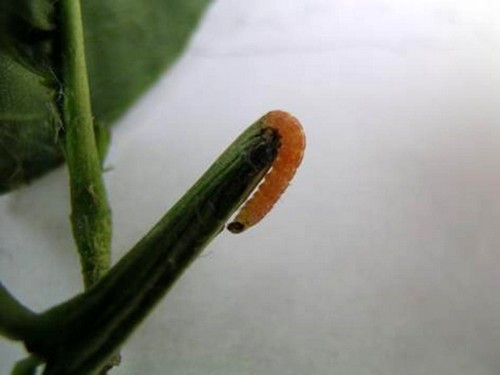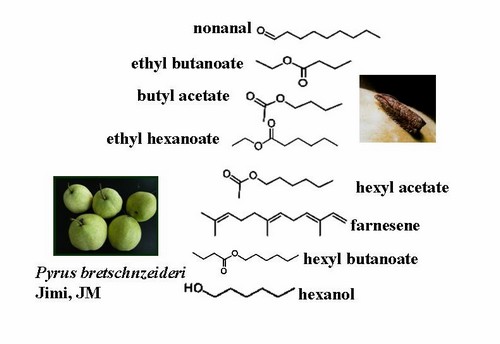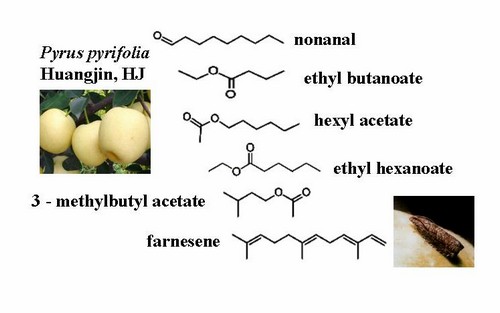The Oriental fruit moth (OFM), Cydia (=Grapholitha) molesta (Busck) (Lepidoptera: Tortricidae) has become widely distributed throughout the stone fruit-growing area in the world.All of its host plants belong to the family Rosaceae, including mainly peach, pear, apple, but also nectarine, plum, cherry, and others. In North China the moth first infests the growing peach and apple shoots in the early growing season and then shifts to pear and apple fruits. In the late season pear trees are the primary OFM host plants. Because of the economic importance of the OFM, its sex pheromone has been studied since the 1960s, and pheromone-based techniques have been established to monitor and control its populations. However, an important drawback in practice is that use of sex pheromone affects only males, while females are directly responsible for infestations by laying eggs on fruits and making inter-orchard flights. The flight performance of females significantly exceeds that of males, and thereby females represent a serious threat to adjacent orchards.
Pears are substantial post-peach resources during the late fruit-growing season. Up to now, there is no report on olfactory orientation of OFM to pear fruits. Professor Chen-Zhu Wang’s team in Institute of Zoology, Chinese Academy of Sciences recently identified and quantified volatiles from immature and mature fruits of six pear varieties by using gas chromatography-mass spectrometry (GC-MS). Attractiveness of the synthetic blends to the adults based on gas chromatography-electroantennogram detection (GC-EAD) activity was investigated in both field and laboratory. Consistent electroantennographic activity was obtained for 12 compounds from headspace collections of the mature fruits of the six pear varieties. Qualitative and quantitative differences were found among six odor profiles. Among the six mixtures, the mixture of 1-hexanol, nonanal, ethyl butanoate, butyl acetate, ethyl hexanoate, hexyl acetate, hexyl butanoate, and farnesene (different isomers) with a 1:1:100:70:7:5:1:4 ratio from the variety Jimi and the mixture of nonanal, ethyl butanoate, 3-methylbutyl acetate, ethyl hexanoate, hexyl acetate, and farnesene with a 1:100:1:32:1:2 ratio from the variety Huangjin were highly attractive to both sexes in the field. The finding indicated that mixtures mimicking Jimi and Huangjin volatiles attracted both females and males of C. molesta, and these host volatiles may also be involved in mate finding behavior.
This work was supported by Public Welfare Project from Ministry of Agriculture and Postdoctoral Science Foundation of China, and just published in Journal of Chemical Ecology.
Article linkage:Lu Peng-Fei, Huang Ling-Qiao, Wang Chen-Zhu. 2012. Identification and field evaluation of pear fruit volatiles attractive to the Oriental fruit moth, Cydia molesta. Journal of Chemical Ecology. DOI 10.1007/s10886-012-0152-4.

Damaged pear fruits by the oriental fruit moths

A larva of the oriental fruit moth

The identified eight compounds from headspace collections of the pear variety Jimi

The identified six compounds from headspace collections of the pear variety Huangjin




